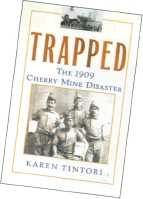 |
Home | Search | Browse | About IPO | Staff | Links |
 |
Home | Search | Browse | About IPO | Staff | Links |
|
Reviews "Everyone knew it was fireproof' Trapped: The 1909 Cherry Mine Disaster 
By Karen Tintori 2002, Atria Books 273 pages, cloth $25 If history tells us anything about the world it's that we needn't look far for our heroes—or our villains. Sometimes it's simply the hour of day that distinguishes them. In Karen Tintoris Trapped: The 1909 Cheny Mine Disaster, the afternoon of November 13, 1909, was the trial, literally by fire, of more than 480 miners who worked for the St. Paul Mining Company in the newly established Bureau County community of Cherry, located fifteen miles northwest of LaSalle-Peru. That more than half of the men died in the mine—leaving more than 200 widows and at least 500 children fatherless—suggests the scope of the tragedy, which is still considered the worst coal mine fire in the nation's history and its third worst mining disaster. Not surprisingly, Cherry's name, like that of Chernobyl, is linked forever to the disaster that branded it in the public memory. Unlike Chicago, which rebuilt after the disastrous fire of 1871, or San Francisco after the 1906 earthquake, Cherry never had a past to glorify or a future to look forward to, though the rich coal deposits under its soil could easily have turned this ethnically diverse community into a prairie Athens rather than the ghost town it is today. The Cherry miners were Lithuanian, Italian, French, Scots, Belgian, German, Irish, Polish, Greek. Swedish, Russian, and American. The shaft they worked was the best—and safest—of its kind, equipped with electric lights in the main thoroughfares, excellent ventilation, and concrete, brick, and steel construction, a feature some claimed made it fireproof. And at the time, the Cherry mine had the largest main shaft in the country. Miners worked two of three rich veins of bituminous coal, the furthest of which was nearly 500 feet below the topsoil. The fire was started by accident when several hay bales in the second vein got too close to a kerosene torch, ignited, and couldn't be extinguished, thereby setting the shaft on fire. Small blazes were seldom cause for concern in the four-year-old Cherry mine, Tintori tells us, because they were easily— and often—put out. Indeed, two hours after the fateful fire started, miners working in the furthest vein had not been told about the fire, simply because management didn't believe a blaze couldn't be contained. By the time the inferno was beyond control, it had engulfed the doomed miners' only means of escape. It is underground where the Cherry Mine heroes emerged—or failed to emerge. Some were lost trying to save themselves, others while looking after their buddies and brothers. Some brave souls dared descend into hell to rescue the men and boys whose wives and sweethearts waited helplessly above ground, where the black smoke billowed ominously. Some came back whole, others burned beyond recognition. Tintori isn't sparing in details; the horror and stench of the fire are palpable, and the carnival-like atmosphere of the rescue operation is all too familiar. Tintori, whose grandfather, John Tintori, survived the Cherry Mine disaster owing to a well-timed hangover, does an excellent job setting the stage for the drama, and delivers a narrative that is both riveting and heartbreaking. Here's a sample: Men couldn't see the roofing overhead, they couldn't see the floor. They couldn't see their hands stretched out in front of them, frantically groping for a wall. They could feel their skin stretch taught over tissue swelling rapidly in the onslaught of heat. They were sweating and suffocating and lost, coughing and vomiting from panic and the smoke. The thunder of fire, the bellow of nudes, the loud staccato reports of heating cracking rock—the din reverberated from every direction. It was diminished only by the most petrifying clamor of them all, a rising crescendo of hundreds of voices shouting, screaming, crying, and praying in a dozen different languages. Unfortunately, Tintori's text reads more like a novel than button-downed history; there is no index, are no notes, and, aside from the reprinted roster of the victims, there is little to document her version of the disaster, aside from the newspapers and letters and notes of the victims, which she quotes from liberally but fails to annotate. But these are more observations rather than criticisms; Trapped is a story full of character and wonderful characters waiting to be told. Tintori should be credited with bringing this all-but-forgotten tragedy so clearly into focus, and for making us care about its hapless victims, whose descendants yet carry the scars deep below the surface of our collective psyche." —William Furry Illinois Heritage 21 |
|
|